“In conclusion” You’ve heard it, you’ve read it, and maybe you’ve used it countless times. But have you ever stopped to think about why this phrase is so common — and powerful?
If you’re writing an email, giving a presentation, or crafting an essay, “in conclusion” is a verbal signpost.
It tells your listener or reader: “Hey, we’re wrapping up here. Get ready for the key takeaway!”
While some may find it overused, “in conclusion” is more than just filler. It helps your message land clearly and leaves a lasting impression.
Without a solid closing statement, your audience may walk away confused or uncertain. That’s where strong conclusion phrases shine.
In this guide, we’ll dive into the different ways to use “in conclusion” effectively. We’ll explore alternatives, when and where to use them, and how to craft closings that stick.
If you’re a student, a business professional, or just someone trying to write better emails, this post has you covered. So, in conclusion… just kidding — let’s begin!
Why “In Conclusion” Matters 🧠
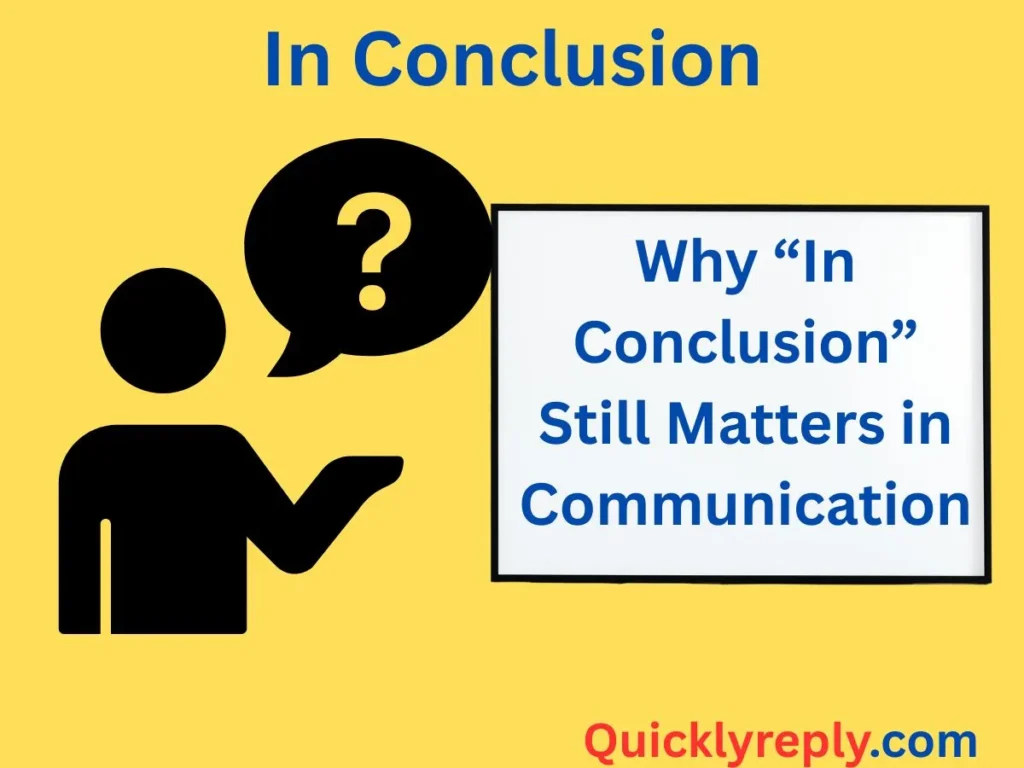
Saying “in conclusion” is like pressing the ‘send’ button on your thoughts. It’s a polite, powerful way to signal that you’re done and your final point is coming. But why is this so crucial?
✨ It brings clarity
Every conversation, paper, or pitch needs closure. A clear wrap-up line prevents misunderstandings and helps others remember your message.
📚 It’s academic and professional
Whether you’re writing an essay or giving a TED Talk, summary phrases like “in conclusion” are expected and respected. They show you’re organized and intentional.
🧩 It ties everything together
Great closings do more than repeat the introduction — they connect the dots, summarize the argument, and leave your audience thinking.
Example:
Imagine a teacher ends a lecture without a summary. Students might forget the point. But ending with “In conclusion, the Civil War was a turning point in American history,” gives direction and focus.
Pro tip: The phrase may be simple, but the way you use it makes all the difference.
🔤 Academic Closers: For Essays and Reports
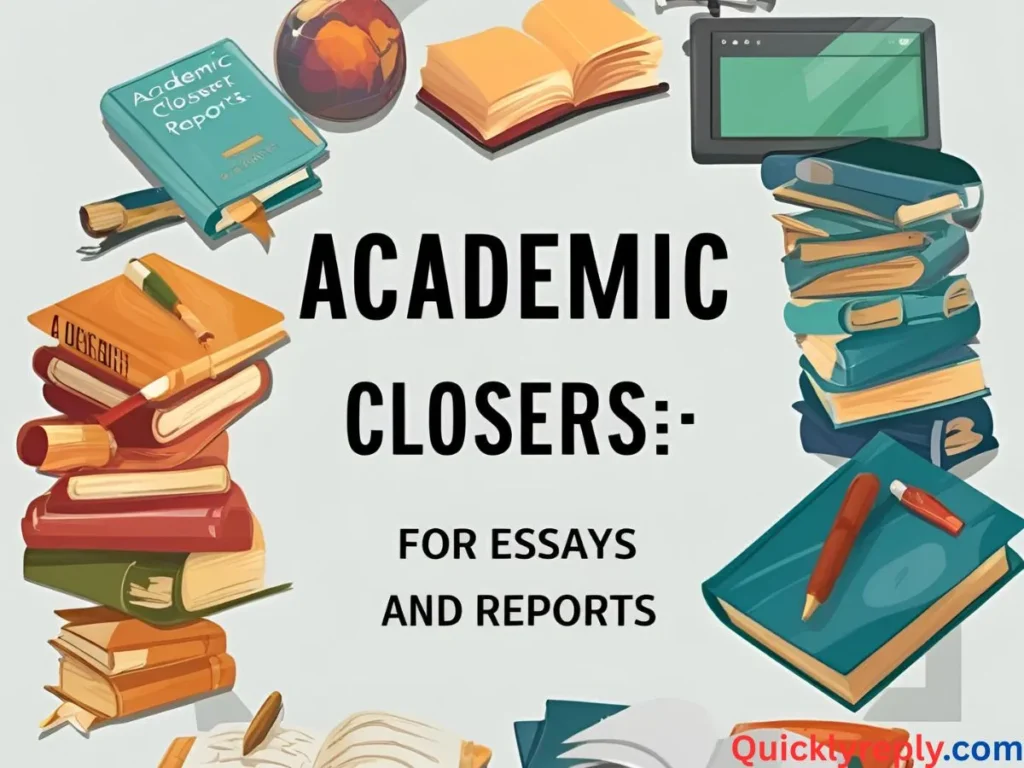
📘 In Conclusion
Explanation: The classic phrase used in essays and academic writing to start your final paragraph.
Use When: You want a formal, expected signal that you’re wrapping things up.
Example: “In conclusion, climate change requires immediate global cooperation to prevent irreversible damage.”
📕 To Sum Up
Explanation: A friendly, concise way to round off ideas.
Use When: Your tone is slightly less formal, like in high school papers or casual presentations.
Example: “To sum up, healthy eating, regular exercise, and good sleep are key to wellness.”
📗 In Summary
Explanation: A flexible phrase that works in essays, speeches, or presentations.
Use When: You want to emphasize the summary of points without sounding too rigid.
Example: “In summary, the results show a strong link between screen time and sleep disruption.”
🧾 Professional Wrap-Ups: For Business and Work Emails
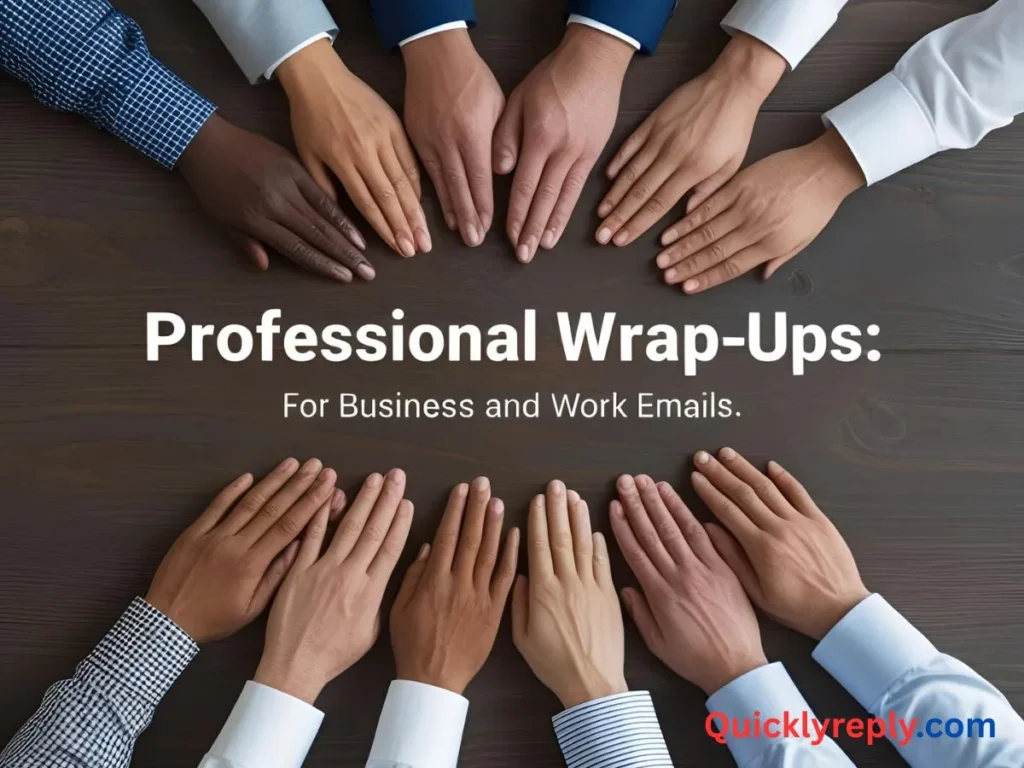
💼 In Closing
Explanation: Slightly more polished and corporate than “in conclusion.”
Use When: Ending emails, pitches, or reports in a professional setting.
Example: “In closing, our team recommends moving forward with Plan B for the next quarter.”
💬 As a Final Point
Explanation: A softer closing that still signals the end of your message.
Use When: You want to end on a thoughtful note without being abrupt.
Example: “As a final point, let’s remember that customer satisfaction drives long-term success.”
📈 To Conclude
Explanation: Direct, professional, and works well in presentations or formal documents.
Use When: Presenting findings or closing a corporate speech.
Example: “To conclude, the data supports our initial hypothesis and suggests further investigation.”
📝 Speech and Presentation Enders 🎤
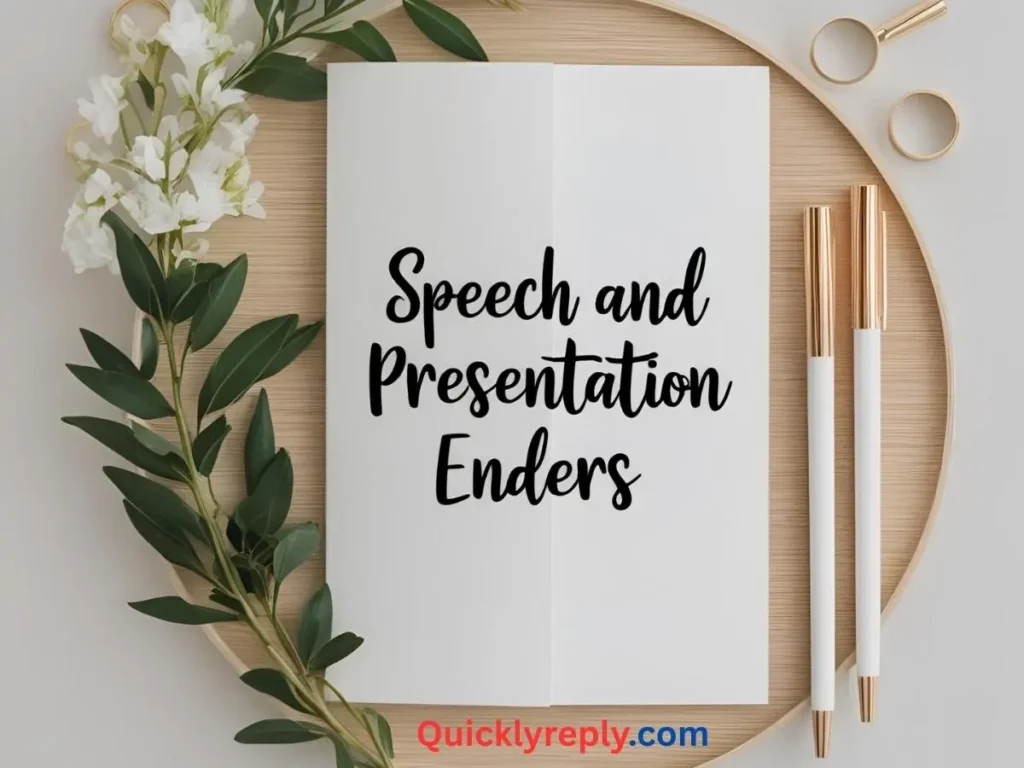
🎯 All Things Considered
Explanation: A reflective phrase that encourages deeper thinking.
Use When: You’re closing a persuasive or narrative speech.
Example: “All things considered, the risks of inaction far outweigh the cost of early intervention.”
🎓 With That Said
Explanation: A smooth transition into your final thought.
Use When: Wrapping up conversational or storytelling presentations.
Example: “With that said, I hope you’ll join us in making change happen.”
🛑 Let Me Leave You With This
Explanation: Adds a powerful, almost cinematic close.
Use When: Delivering a motivational or emotional speech.
Example: “Let me leave you with this: small steps, taken consistently, lead to big change.”
💌 Email and Message Sign-Offs
📬 In Short
Explanation: Simple, straight-to-the-point summary line.
Use When: Wrapping up ideas in informal emails or newsletters.
Example: “In short, let’s finalize the designs by Friday and reconvene Monday.”
✅ That’s All For Now
Explanation: Casual and conversational.
Use When: Ending friendly or internal team emails.
Example: “That’s all for now — let me know if anything’s unclear!”
🧾 TL;DR (Too Long; Didn’t Read)
Explanation: Internet slang that summarizes long messages in one line.
Use When: Recapping emails or messages in digital communication.
Example: “TL;DR: We’re launching on Monday, and you’re invited to help test.”
🧠 Creative Conclusion Starters
🎨 Wrapping It All Together
Explanation: More creative and informal than “in conclusion.”
Use When: Blogging, storytelling, or casual presentations.
Example: “Wrapping it all together, this journey taught me the power of resilience.”
🧵 Tying Up Loose Ends
Explanation: Suggests you’re neatly finishing a complex discussion.
Use When: Writing long-form articles or closing debates.
Example: “Tying up loose ends, we see both sides have valid points — but the evidence leans toward action.”
🕊️ As We Draw to a Close
Explanation: Graceful and formal, often used in speeches or heartfelt messages.
Use When: Ending memorials, retirement speeches, or ceremonial talks.
Example: “As we draw to a close, I want to thank everyone for their support and guidance.”
🤓 Academic and Research Writing Alternatives
🧪 To Recap
Explanation: A great option when summarizing data or research.
Use When: Academic papers, presentations, or technical writing.
Example: “To recap, the experiment confirmed the hypothesis across all three test groups.”
📝 Final Thoughts
Explanation: A common wrap-up for blog posts and essays.
Use When: Reflecting or sharing opinions at the end of research or opinion pieces.
Example: “Final thoughts: while progress has been made, more work is still needed.”
🔍 The Bottom Line
Explanation: Direct, results-oriented phrasing.
Use When: Concluding research summaries or case studies.
Example: “The bottom line: automation cut costs by 30% within six months.”
🥂 Event and Toast Closures
🥳 Cheers to That
Explanation: Uplifting and social closing.
Use When: Giving a toast, celebrating wins, or hosting events.
Example: “We’ve worked hard, laughed harder, and grown closer. Cheers to that!”
🎊 Here’s to the Future
Explanation: Forward-looking and hopeful.
Use When: Graduation speeches, retirement parties, or end-of-year events.
Example: “Here’s to the future — may it be bright, bold, and full of promise.”
🕯️ With Gratitude
Explanation: Sincere and reflective.
Use When: Expressing thanks at the end of heartfelt events.
Example: “With gratitude, I thank you all for making this journey unforgettable.”
🧭 Final Thoughts
“In conclusion” isn’t just a phrase — it’s a moment. It’s when your audience leans in to hear your final word. Whether you’re trying to inspire, convince, or simply summarize, choosing the right closing statement changes everything.
Action tip: Match your conclusion to your context. If you’re writing a school paper, stick with the classics. Giving a toast? Get creative. Ending an email? Be warm and clear.
A strong wrap-up doesn’t just summarize — it leaves people thinking, feeling, and remembering.
📊 Bonus Recap Table: Closing Phrases & Examples
| Category | Phrase | Use When | Example |
| Academic | In Conclusion | Formal essays and school writing | “In conclusion, renewable energy is vital for our future.” |
| Professional | In Closing | Business emails or reports | “In closing, our team agrees on the proposed direction.” |
| Speeches | Let Me Leave You With This | Motivational or inspirational talks | “Let me leave you with this: kindness is never wasted.” |
| In Short | Casual email wrap-ups | “In short, we’ll meet next Tuesday at 10 a.m.” | |
| Creative | Wrapping It All Together | Blog posts or personal reflections | “Wrapping it all together, this story reminds us to stay hopeful.” |
| Academic/Research | Final Thoughts | Summary sections of research or essays | “Final thoughts: the study shows promising trends for early detection.” |
| Event | Here’s to the Future | Toasts or event closings | “Here’s to the future — filled with opportunity and joy.” |

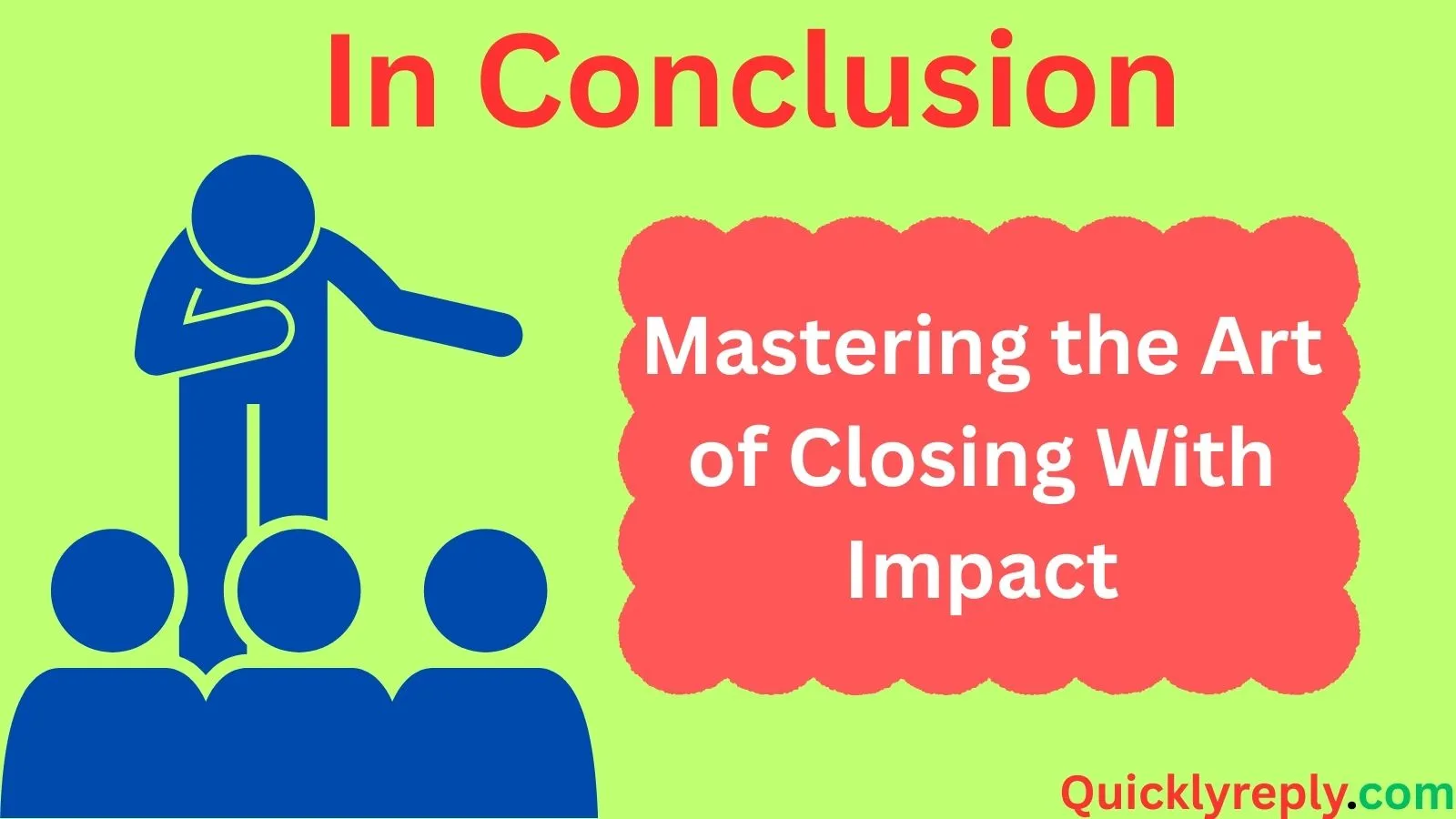
Leave a Reply